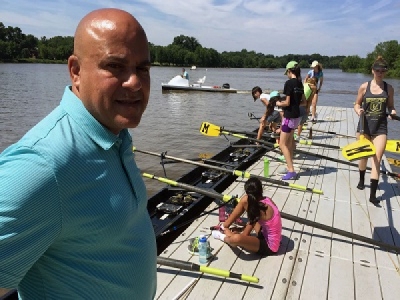
Posted on July 28, 2016
By David O'Reilly, philly.com
Nearly a year after a major dredging operation began shutting it down, boating on the Cooper River seemed back to normal Tuesday.
Sailboats tacked into light breezes, a kayak skimmed along the Pennsauken shore, and three sleek shells packed with young rowers from Moorestown glided west.
But shouts and a shrill whistle – even a waterborne visit from “law enforcement” – will greet any boater who gets close to that new line of white buoys stretched across the river.
To its east lie the two miles of submerged pipes, suction equipment, and dredge boats of Camden County’s $10.5 million channel-deepening operation, which resumed July 1 after a three-month pause.
“They can’t go there,” explained 19-year-old Helena Sirken, who stood inside the Cooper River Yacht Club with a whistle around her neck.
A steward at the club, her tank top bore the words “River Patrol.” She and the club are “the law” on the Cooper through the end of August.
Thanks to a novel arrangement that went into effect July 1, Camden County and the sailing and rowing clubs here have a way to keep boats on most of the Cooper during the dredge operation’s final phase.
All vessels are obliged to stay west of the buoys, which each read “No boating beyond this point,” while the dredge contractor continues to deepen the channel.
Cooper River Yacht Club – which sits on the Collingswood side of the river, 50 yards west of the buoy line – enforces the arrangement, along with the coaches of the rowing teams.
“We’ve had a couple of incidents involving kayaks” that have slipped under the buoy line despite the warnings, said Sirken, a steward at the club.
But the high school crews have been scrupulous about keeping their distance, she said, and the eastern end of the river is too shallow, for now, for sailboats.
The project, which is using an Ellicott 370 dredge, is due to end the first week of August, said Frank Moran, director of the Camden County Parks Department. The pipes and other equipment should be out of the water by Sept. 1, he said.
Freeholder Jeffrey L. Nash, who oversees the parks department, said the dredging contractor was working “around the clock” to meet the deadline.
The project calls for removing 115,000 cubic yards of silt from the main channel of the river, which had silted to a depth of two feet or less in places. Moran said only about 8,000 cubic yards remain to be dredged.
Allowing boats on the river during dredging is a marked change from the county’s previous policy, which the boat clubs say was disruptive and frustrating. But for safety and liability reasons, Camden barred all boats from the tidal portion of the Cooper starting Aug. 17, 2015, and into early April.
The ban not only forced rowing clubs to find other venues to practice, but obliged numerous regattas to relocate elsewhere.
“We didn’t have the Garden State Championship at all this year” because of the ban, said Rich Henderson, head coach of Moorestown High School’s rowing program. That regatta typically brings 5,000 rowers and 15,000 spectators, he said.
The ban “nearly killed us,” Ralph Talbot, commodore of the Cooper River Yacht Club, said Tuesday. “That’s why we worked out this deal” with Moran.
Under DEP regulations, the dredging contractor, Mount Construction Co. of Berlin Township, had to cease operations between April 1 and June 30 because it was spawning season for several species of fish.
Faced with a resumption of dredging starting July 1, the boat clubs urged the county to let them use the river while they themselves made sure all boats stayed far from the potentially dangerous dredge.
“It works,” said Talbot. “Now we’re popping,” he said, pointing out 18 mostly preteen youngsters enrolled in this year at the club’s sail camp as they ate lunch at indoor picnic tables.
The club also has about 160 members who race Lasers, Sunfish, and GP14 sailboats or sail here in the evenings and on weekends.
For the high school rowing clubs, such as Moorestown Crew, access to a confined portion of river is an acceptable compromise.
“We’ve got 1,500 meters, which is the length of a high school racecourse,” Henderson said Tuesday as novices lugged their shells overhead to the boat house’s storage bays.
Two thousand meters would be ideal, Henderson said with a shrug. “The longer the better. But three-quarters of a river is plenty to learn to row.”
The calm Cooper is far safer than the Delaware River, where his crew practiced in March and early April, he said.
On the Delaware, where they practiced off Delran, choppy water made it unsafe to put boats in the water and once swamped a shell, sending rowers into the river.
Gregg Francis, coach of Haddon Township High School’s program, said it was “nice to be back after all the craziness.”
The ban, which obliged his team to practice on the Delaware and required students to travel 35 minutes each way to practices, significantly reduced student participation in his program, said Francis.
“We’re very excited this whole thing is coming to an end,” he said. “There’s going to be a lot more rowing space when it’s done. And even though the process wasn’t perfect, I’m thrilled with the results.”
Source: philly.com





